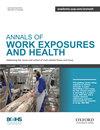221 职业接触石墨烯纳米形式的风险评估 - 我们在哪里?
IF 1.8
4区 医学
Q3 PUBLIC, ENVIRONMENTAL & OCCUPATIONAL HEALTH
引用次数: 0
摘要
背景 石墨烯是一种二维材料,具有许多有用的特性,如柔韧性、弹性和导电性等。因此,石墨烯将来可能成为许多职业领域使用的材料,从而导致职业接触。目前,人们对石墨烯材料在职业环境中的内在危害和暴露程度都没有足够的了解,因此无法为职业风险评估提供依据。有许多出版物(>300)涉及石墨烯和石墨烯形式的毒性,但缺乏与人类接触的明显、可靠和广泛认同的联系。与此同时,针对石墨烯的职业接触评估也因缺乏有效的测量技术而受到影响。因此,我们最近提出了一种基于碳元素(EC)定量的方法,这种方法既经济又易于使用。目的 了解哪些毒理学方法可用于研究通过呼吸系统接触石墨烯造成的局部或全身影响,并将相关知识纳入讨论。方法 文献综述,重点关注与石墨烯沉积和下呼吸系统吸收相关或可能相关的方法。结果 对可能与人类不良后果相关的方法及其各自的终点进行映射。该图谱显示,从毒性测试到人体风险评估仍存在知识差距。结论 有必要讨论和决定进一步的补充测试。本研究提出了两个不同的出发点。本文章由计算机程序翻译,如有差异,请以英文原文为准。
221 Risk assessment of occupational exposure to graphene nanoforms - Where are we?
Background Graphene is a 2D-material with many useful properties such as flexibility, elasticity, and conductivity among others. Graphene could therefore become a material used in many occupational fields in the future, and thereby lead to occupational exposure. Today, neither intrinsic hazards with the material in occupational settings nor the extent of exposures are sufficiently known in order to form a basis for occupational risk assessment. There are many publications (>300) dealing with toxicity of graphene and graphene forms, but an evident, reliable and broadly agreed link to human exposure is lacking. In parallel, occupational exposure assessment targeting graphene has suffered from the lack of efficient measuring techniques. Recently we therefore presented a method that is cost-effective and easy-to-use based on quantification of elemental carbon (EC). Aim To find out which toxicological methods that can be relevant for the study of local or systemic effects from graphene exposure through the respiratory system and bring the knowledge to discussion. Method Literature review focusing on methods that are or might be relevant to graphene deposition and uptake in the lower respiratory system. Outcome A mapping of methods and their respective end points that can be related to adverse outcomes in humans. The mapping reveals that there is still a knowledge gap going from toxicity testing to human risk assessment. Conclusions There is a need to discuss and decide on further and complementary testing. The present study brings two different starting points.
求助全文
通过发布文献求助,成功后即可免费获取论文全文。
去求助
来源期刊

Annals Of Work Exposures and Health
Medicine-Public Health, Environmental and Occupational Health
CiteScore
4.60
自引率
19.20%
发文量
79
期刊介绍:
About the Journal
Annals of Work Exposures and Health is dedicated to presenting advances in exposure science supporting the recognition, quantification, and control of exposures at work, and epidemiological studies on their effects on human health and well-being. A key question we apply to submission is, "Is this paper going to help readers better understand, quantify, and control conditions at work that adversely or positively affect health and well-being?"
We are interested in high quality scientific research addressing:
the quantification of work exposures, including chemical, biological, physical, biomechanical, and psychosocial, and the elements of work organization giving rise to such exposures;
the relationship between these exposures and the acute and chronic health consequences for those exposed and their families and communities;
populations at special risk of work-related exposures including women, under-represented minorities, immigrants, and other vulnerable groups such as temporary, contingent and informal sector workers;
the effectiveness of interventions addressing exposure and risk including production technologies, work process engineering, and personal protective systems;
policies and management approaches to reduce risk and improve health and well-being among workers, their families or communities;
methodologies and mechanisms that underlie the quantification and/or control of exposure and risk.
There is heavy pressure on space in the journal, and the above interests mean that we do not usually publish papers that simply report local conditions without generalizable results. We are also unlikely to publish reports on human health and well-being without information on the work exposure characteristics giving rise to the effects. We particularly welcome contributions from scientists based in, or addressing conditions in, developing economies that fall within the above scope.
 求助内容:
求助内容: 应助结果提醒方式:
应助结果提醒方式:


